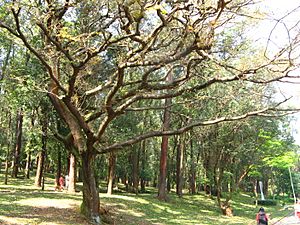Diesel tree facts for kids
Quick facts for kids Diesel tree |
|
|---|---|
 |
|
| Copaifera langsdorfii in a park in São Paulo Brazil | |
| Conservation status | |
| Scientific classification | |
| Genus: |
Copaifera
|
| Species: |
langsdorffii
|
The diesel tree (scientific name: Copaifera langsdorffii) is a special tree from tropical rainforests. People in different places call it by names like kupa'y, cabismo, or copaúva. It's known as the "diesel tree" because it produces an oily liquid that can be used like fuel!
Contents
What the Diesel Tree Looks Like
The diesel tree is a medium to large tree. It usually grows up to about 12 meters (around 40 feet) tall. It has pretty white flowers and small, oily fruits.
The wood of this tree is light. It has tiny channels inside that are filled with oil. To collect this oil, people make a cut in the tree. The oil then slowly drips out into the cut, making it easy to gather. This tree grows best in warm, tropical places.
How People Use the Diesel Tree
Fuel from the Tree
The diesel tree makes special oily liquids called hydrocarbons in its wood and leaves. Because of this, people have been interested in it as a way to get renewable energy.
Some early stories said that one tree could give about 40 liters (10 gallons) of oil. They also said that a field with 100 grown trees could make 25 barrels of oil each year. These stories became popular in 2007. An Australian person even brought seeds to Australia hoping to grow diesel fuel.
However, later studies showed that the trees don't actually produce that much oil. Small trees don't make any oil at all. Medium-sized trees produce more oil than very large ones. No tree in these studies made more than 1 liter (about 0.25 gallons) of fuel. Another study in 2006 agreed with these findings. It also found that spring was the best time to collect oil from the trees.
So, it seems unlikely that the diesel tree will be a big source of fuel. The main oily liquid from the tree is called copaiba. This oil can be used to make products like lacquers. After being cleaned, this oil can even be used in a regular diesel car engine. Some local people have also used this tree's oil for cooking.
Strong Wood for Building
The wood from the diesel tree is very strong. It doesn't rot easily. Because of this, people in places where the tree grows use its wood for carpentry and building things.
Helpful for Bees
European honey bees really like the diesel tree. They are very attracted to its pollen. This makes the tree important for apiculture (beekeeping) in Brazil.
Traditional Medicine Uses
Native people in the Amazon use the oil from the diesel tree as a traditional medicine. They mainly use it to help with coughs and as an antiseptic (to kill germs). They also use it to treat skin problems like eczema and other skin conditions. Recently, people have also found that this oil is very good for healing. This has made the oil even more valuable.
See also
 In Spanish: Copaiba para niños
In Spanish: Copaiba para niños



